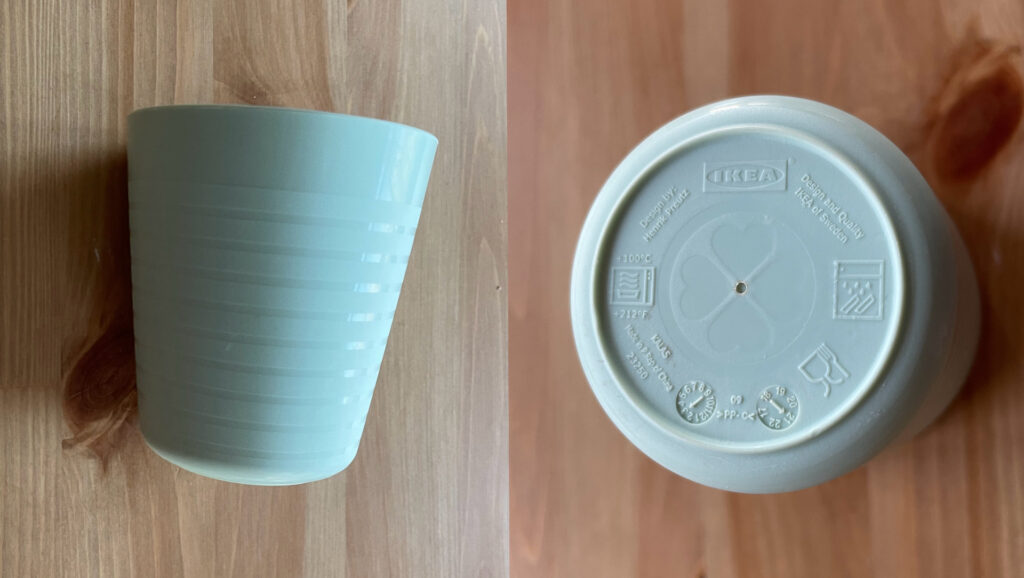This product is part of IKEA’s plastic tumbler series for kids. It was purchased new in 2022. We use these in a pinch for cold liquids when our stainless or glass cups are unavailable. The IKEA logo is molded on the base of the cup. They are flexible and made of polypropylene.
How do you think our cup tested using XRF?

Reading on the Plastic Base:
| Element of Interest | Parts per million (ppm) | Error Range |
|---|---|---|
| None Detected | ||
| Other Elements | ||
| Nickel (Ni) | 16 | +/- 5 |
| Copper (Cu) | 11 | +/- 6 |
| Titanium (Ti) | 9,117 | +/- 162 |
| Iron (Fe) | 305 | +/- 14 |
The sample was tested in consumer goods TestAll mode using a Niton XL3t 700S for 60 seconds. Results are rounded to the nearest whole number.
Test Summary:
No elements of interest were detected via XRF.
Well, if you know our blog you know we are fans of stainless steel and glass for cups and plates. We favor these other alternatives over plastic since plastic can leach chemicals into food through heat or prolonged contact. However, we do sometimes use plastic cups and bowls for cold food or snacks such as chips where heat and prolonged contact are not a concern. As a bonus plastic is inexpensive and new polypropylene plastic is generally lead free.
Not surprisingly, this item tested is below the federal lead restrictions for children’s products which limits products intended for use by children 12 and under to 90-100 parts per million lead.
This item is a new children’s product and is subject to these regulations.
Some families may prefer to avoid plastic cups and plates because they want to reduce exposure to micro plastics from their products. We understand their concerns but think plastic plates and cups our a good option for some families.
We think this is a decent product for children by a reputable company. IKEA has a lot of better non-toxic options for the public when compared to other retailers, for a variety of substances. They not only restrict lead and cadmium, but they do not apply PFAS to their textiles and furnishings, which is a big selling point. That being said, I would not expect to find lead or cadmium in any new plastic cups and plates.
We Prefer:
We like stainless steel cups for camping or children who are too young to use breakable, glass-based cups. New plastic is very unlikely to contain lead and may be a good option for your family.
We recommend avoiding vintage ceramic or painted glass cups, or older plastic cups, which can contain high levels of lead or BPA. When glass is not an option, we sometimes use new polypropylene cups for cold foods in a pinch.
When possible, we recommend that all items used by children in the kitchen be lead free, with the exception of trace lead in products that are leach tested, preferably under 90 ppm lead on surface coatings, which is considered to be within legal safety limits for children’ s products.
Better Cups:
Disclosure: These are Amazon affiliate links. By shopping for any item on Amazon starting with our links, you help support our business and testing.
The direct link to the IKEA product is here. It is also available on Amazon:
IKEA – KALAS Tumbler, Assorted Colors


Why we like it: These cups are made in the USA from recycled milk jugs. How wholesome is that?
Arrow Home Products Sip A Cup with Built in Straw, 10oz, 6pk – BPA-free Straw Cups for Kids

Why we like it: Here is another polypropylene plastic cup made in the USA.
Disclaimer: These items have not always been personally tested by us but are likely to be lead free or low lead and/or cadmium based on our research into the materials, discussions with manufacturers, and/or testing on similar products. We recommend items we would use ourselves.
We provide our XRF testing for general educational or informational purposes only to help consumers identify low lead and lead-free products. We hereby disclaim any and all warranties, expressed or implied, and assume no duty or responsibility with respect to how any person or entity chooses to use the information on this website.

